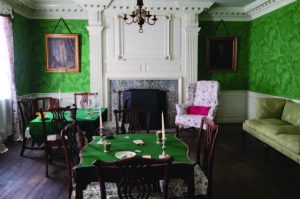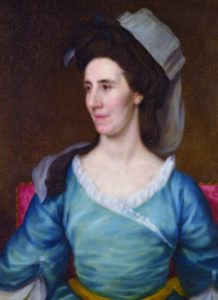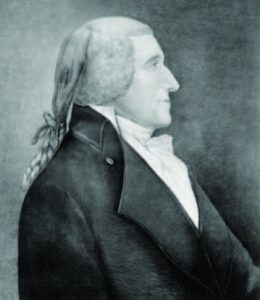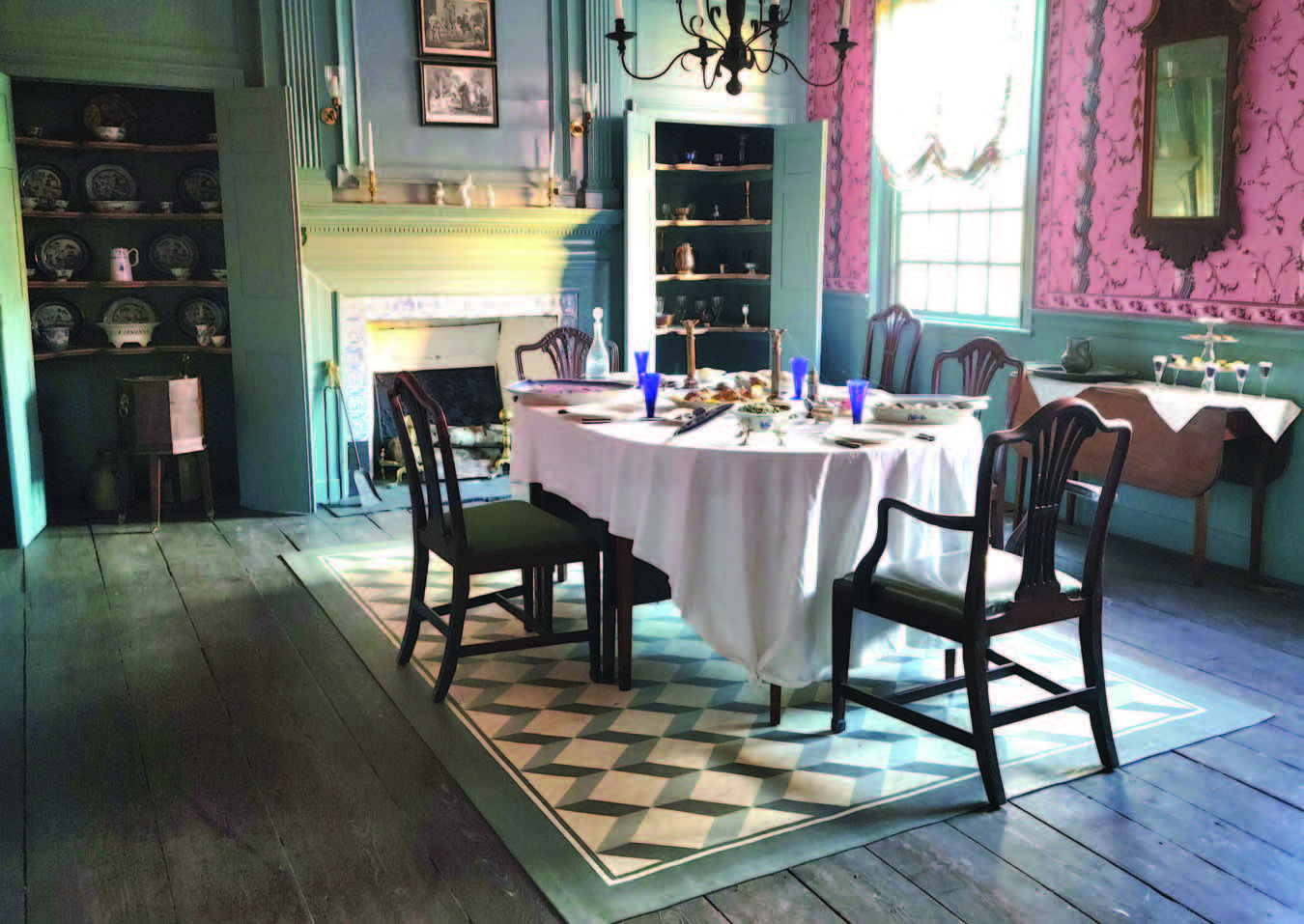Museum people like to say they eat and sleep their jobs.
Meet someone who actually does.
The folks who look after New Jersey’s historical structures and small museums have much in common, starting with their daily routine. They arrive at work each morning, walk up to the front door, turn a key, and then ready themselves for the day’s steady stream of visitors. One notable exception is Katherine Craig, who is in charge of the crimson-shingled mid-1700s structure located on East Jersey Street in Elizabeth.
In her case, the unlocking happens from the inside. Because Katherine Craig actually lives in Boxwood Hall. And in the museum world, this makes Craig decidedly uncommon.
Although Craig performs the typical, day-to-day duties of a curator—arranging displays, designing new exhibits, conducting tours and lots and lots of paperwork—her official title is caretaker. Because Boxwood Hall is nearly 300 years old, the state requires that someone with an intimate knowledge of the house make note of (and if possible take care of) any necessary repairs—full-time, around the clock. “It is like living above the family business,” she says. “Living here makes it possible to know every nook and cranny of the house.”

This arrangement makes Craig the most-qualified person on Earth to educate people about Boxwood Hall, from groups of wide-eyed elementary schoolers to day tourists to hardcore history junkies. Not surprisingly, she has become quite adept at tailoring her tours to the age and interests of her visitors. A group of architects came just to study the building’s original door hinges and support beams, which naturally she knew plenty about. “They could give two pins about the Revolutionary War, and that’s okay!”
Craig studied biology at Rutgers before becoming a tour guide at Sandy Hook National Park. When presented with the opportunity to serve Boxwood Hall as its full-time, live-in guardian, her first thought was, I can do that!
The Rest Is History…Literally

Vinny Fleming
Impressed by the long list of prominent and influential Americans who lived in and visited Boxwood Hall, Katherine Craig applied for and got the job in 1981. She was also intrigued by the ways in which Boxwood Hall changed with the times, putting on different faces to preserve itself and its legacy, and decided to turn its evolution into storytelling opportunities.
The earliest chapter of Boxwood Hall’s story dates back to 1750, when it was built for 40-year-old Samuel Woodruff, one of 13 children born to Captain Joseph Woodruff, who moved from Long Island to New Jersey as a young man and settled in current-day Cranford. At the time of construction, Samuel was serving as the second mayor of Elizabeth (then known as Elizabethtown), an office he would hold for 14 years. Upon his demise in 1768, Samuel passed Boxwood Hall to his son, John, who in turn put the property up for auction, in 1768. By this point, Elizabethtown had become a well-established and prosperous city, with a population of perhaps 2,000 people. The prestige associated with owning one of the most important homes in one of Colonial America’s most important towns had particular appeal to the winning bidder, a 28-year-old lawyer named Elias Boudinot (above).
The Boudinots, a Huguenot family that fled religious persecution in France in the 1680s, had built an impressive fortune as merchants and silversmiths. Growing up in Philadelphia, Elias was a neighbor and friend of Benjamin Franklin. However, Boudinot business interests had not fared well in the 1760s. Elias figured that buying Boxwood Hall was a prudent first step on the way to rebuilding his family’s reputation. Little did he suspect how prominent the Boudinot name would soon become.
Elias was already moving in impressive circles. He had studied law at Princeton under Richard Stockton, who would add his signature to the Declaration of Independence a few years later. Stockton was married to Annis Boudinot, Elias’s older sister. Elias, in turn, married Hannah Stockton (left), Richard’s younger sister. Elias and Hannah’s daughter, Susan, grew up to marry William Bradford, George Washington’s attorney general. When Bradford passed away in 1795, Susan moved back to Boxwood Hall. Elias, Hannah and Susan lived together in the home for another decade before moving to South Jersey.
By then, Katherine Craig points out, Boxwood Hall had already seen quite a bit of history.
In 1772, an ambitious teenager named Alexander Hamilton enrolled at the Elizabethtown Academy and lived with friends of the Boudinots, Susannah and William Livingston. Like Richard Stockton, William Livingston—a future Governor of New Jersey—would also lend his signature to the Declaration of Independence. Hamilton was a frequent visitor to Boxwood Hall, which was fast becoming a hotbed of revolutionary activity.
Elias Boudinot aligned himself with the American revolutionaries and, once the shooting started, used his wealth and influence to encourage enlistment, procure supplies and support a network of spies. General Washington tasked Elias to oversee the Continental Army’s prisoner situation and commissioned him as a colonel. In 1781, when the outcome of the war was very much in doubt, Boudinot was appointed as a delegate to the Continental Congress and, in 1782, was elected as the body’s president for a one-year term. Under the Articles of Confederation, the position was mostly ceremonial, however his time in office was notable for being America’s first peacetime president.


After the Articles were replaced by the U.S. Constitution and Washington was named President of the United States, Washington stopped at Boxwood Hall before boarding a special barge that transported him across the river to New York for his inauguration. Following three terms in the US House of Representatives, Boudinot was appointed by Washington as Director of the US Mint—an appointment that may have been influenced by his relationship with Alexander Hamilton.
Following the Boudinots’ departure in 1805, Boxwood Hall came into the possession of retiring Senator Jonathan Dayton. Dayton had succeeded Boudinot as a US representative and also served as US Speaker of the House. Dayton was a friend and classmate of Alexander Hamilton at Elizabethtown Academy and almost certainly spent time in Boxwood Hall as a young man. Elias Boudinot and Jonathan Dayton had something else in common: both claimed sizeable real estate holdings in Ohio. In fact, the Ohio city of Dayton was named for the third owner of Boxwood Hall, even though he never set foot in the Buckeye State.
As Katherine Craig points out on her tour, Dayton got into hot water later in life for his association with the notorious Aaron Burr—who was also educated down the street at Elizabethtown Academy and who killed Hamilton in a duel in Weehawken. Small world, although for Hamilton apparently not big enough.
Changing with the Times
As Elizabeth grew up around Boxwood Hall, its purpose changed. After changing hands several times in the 19th and early 20th centuries, the building became the Elizabeth Home for Aged Women. It was not a final landing place for the destitute or infirm. As Tony Soprano insisted to his mother It’s not a nursing home, it’s a retirement community! so too was Boxwood Hall. It was a place for older women of sound mind and body, who for whatever reason, couldn’t afford their own housing. The women residing there participated in a variety of social functions and produced crafts such as needlepoint and crochet that could be sold to support the home.
In 1941, the state took over operation of Boxwood Hall. Over the next few decades, generous private donations of furniture and accessories from local residents slowly filled the building. When Craig began her duties at Boxwood Hall, the antiques were jumbled throughout the various rooms, without much rhyme or reason. But Craig instantly saw the potential.

“When I first got there, it looked too much like a furniture store,” she recalls. “It was like the world’s biggest dollhouse. I thought each room should represent one of the different periods of its history.”
So now it does. The curated period décor, in fact, helps Craig set the scene as she moves from room to room, guiding visitors through the evolution of the historic home. On her tours, she talks about the other iterations of the mansion, including stints as a school for girls and as home to the Red Cross.
Craig also talks about the architectural history of Boxwood Hall and changes in the surrounding neighborhood. At the conclusion of her tours, you feel as if you’ve walked in the footsteps of its many residents. Which, Craig maintains, is the best takeaway: “Whether it is someone famous, infamous or almost forgotten, when we look back, we are talking about human beings, not cardboard cut-outs.”
Editor’s Note: That Boxwood Hall is standing at all is a testament to the people of Elizabeth. Long before Craig arrived, the structure fell into disrepair and was slated for demolition. A group of citizens raised the funds needed to buy and renovate the property, and then deeded it to the state so it could be run as a museum. Boxwood Hall is open to visitors Monday thru Friday from 9:00 to 5:00, with an hour break from noon to 1:00. The museum is closed on weekends because Katherine Craig has a life, too.







